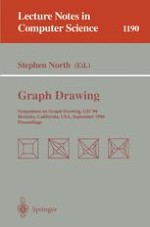1997 | Buch
Graph Drawing
Symposium on Graph Drawing, GD '96 Berkeley, California, USA, September 18–20, 1996 Proceedings
herausgegeben von: Stephen North
Verlag: Springer Berlin Heidelberg
Buchreihe : Lecture Notes in Computer Science
Enthalten in: Professional Book Archive
